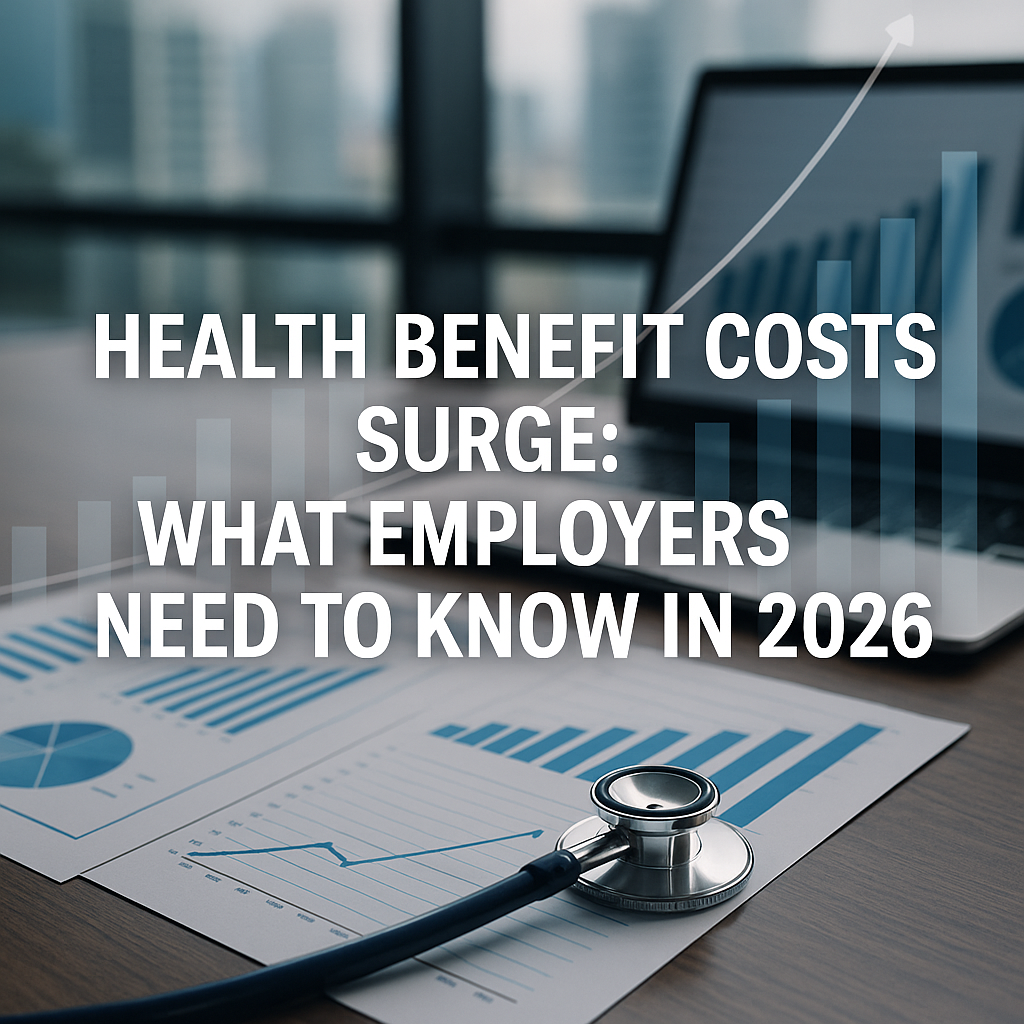Health benefit costs are climbing at the fastest pace in more than a decade. According to Mercer’s preliminary National Survey of Employer-Sponsored Health Plans, U.S. employers expect an average 6.5% increase in health benefit costs per employee for 2026 — the steepest rise since 2010 (Mercer, Sept. 2025).
Other research supports an even more concerning trend:
- The Business Group on Health (BGH) forecasts a 9% increase in employer healthcare costs for 2026 (BGH, Aug. 2025).
- The International Foundation of Employee Benefit Plans (IFEBP) projects a 10% jump, citing higher medical utilization and drug costs (IFEBP, Sept. 2025).
The convergence of cost drivers means employers must prepare for sustained pressure on health plan budgets through 2026 and beyond.
What’s Driving the Cost Surge
1. Higher Prices Across the Healthcare System
Mercer attributes much of the increase to inflationary pressures in healthcare services and products. Prices for specialty drugs, advanced diagnostics, and novel therapies — particularly GLP-1 weight-loss and diabetes medications — have grown faster than general inflation (Mercer, 2025).
Hospital and provider consolidation is another driver. As large health systems gain negotiating power, they command higher reimbursement rates from insurers, further fueling employer costs (WorldatWork, Sept. 2025).
- Rising Utilization and Deferred Care
Many employees postponed medical care during the pandemic, creating a surge in demand for elective procedures, chronic disease management, and preventive services. Increased use of virtual care and behavioral health services also contributes to the uptick (Mercer, 2025).
Employers report a notable rebound in doctor visits, diagnostic screenings, and outpatient care — trends that collectively raise per-employee spending.
- Escalating Pharmacy Costs
Prescription drugs, particularly specialty medications, now account for roughly 25% of total employer healthcare spending, up sharply from a decade ago (Business Group on Health, 2025).
Employers cite the introduction of new high-cost therapies, limited biosimilar adoption, and complex PBM pricing structures as key contributors.
Employer Responses and Strategies
Cost-Sharing Adjustments
To offset rising costs, employers are increasingly passing on a portion of expenses to workers. Mercer found that 59% of employers expect to make cost-cutting changes in 2026, compared with 48% in 2025 (Mercer, 2025).
Common adjustments include:
- Raising employee premium contributions
- Increasing deductibles and copays
- Tightening dependent eligibility and audits
Plan Design and Network Optimization
Some employers are reengineering plan designs to focus on value and efficiency:
- Expanding narrow networks and high-performance providers
- Promoting centers of excellence for complex procedures
- Offering tiered plans with varying cost levels and benefits
- Integrating High Deductible Health Plans (HDHPs) with Health Savings Accounts (HSAs)
Targeted Cost Management Initiatives
Organizations are also deploying more sophisticated cost-control measures:
- High-cost claims management and predictive analytics
- Pharmacy benefit oversight (rebate transparency, utilization controls)
- Behavioral health and chronic care programs to reduce long-term medical costs
- Employee decision support tools for selecting cost-effective providers (WorldatWork, 2025)
Employer Actions and Outlook for 2026
As health benefit costs continue to climb, employers are reassessing plan structures, cost-sharing strategies, and vendor relationships. Survey data from Mercer and the Business Group on Health show that many organizations are taking a measured, data-informed approach to budgeting and benefits design.
Emerging Focus Areas
- Scenario Planning:
Employers are modeling multiple cost scenarios — typically ranging from 6% to 10% annual growth — to plan budgets and renewals more accurately. - Data and Analytics:
More organizations are investing in analytics platforms to identify high-cost claims, chronic condition patterns, and utilization trends. - Pharmacy Benefit Oversight:
Employers are reviewing PBM contracts and evaluating transparent pricing or direct sourcing models in response to rising specialty drug costs. - Plan Design Adjustments:
Some companies are exploring high-performance networks, tiered benefits, and value-based contracts to better manage provider costs. - Employee Communication:
Clear communication around benefit design and cost-sharing changes remains a focus to ensure employees understand available options and resources. - Population Health Initiatives:
Wellness and preventive care programs continue to be evaluated for their potential to improve long-term outcomes and manage chronic disease costs.
While responses vary across industries, the broader trend points toward strategic recalibration rather than short-term cost-cutting. Most employers aim to balance affordability, workforce satisfaction, and overall plan sustainability through 2026.
Balancing Costs, Retention, and Health Outcomes
Analysts note that excessive cost-shifting may discourage necessary care and negatively affect workforce health. Maintaining a balance between affordability and access remains a key concern for employers navigating this cost environment (IFEBP, 2025).
With talent competition still tight, benefits packages are viewed as central to recruitment and retention. Employers that preserve coverage quality while managing costs strategically are likely to remain more competitive in attracting and retaining skilled workers.
Summary
- Employer health benefit costs are projected to rise 6.5% to 10% in 2026, marking the steepest increase in 15 years.
- Cost drivers include healthcare price inflation, increased utilization, and rising pharmacy costs.
- Employers are responding with plan redesigns, PBM reviews, and data-driven management rather than broad cost cuts.
- Balancing affordability, competitiveness, and health outcomes will be essential for sustainable strategies in 2026.
FAQ
Q: Why are 2026 cost projections higher than in recent years?
A: Prices for medical services and drugs are increasing at the same time as utilization rises — a dual trend not seen since before the pandemic (Mercer, 2025).
Q: Are smaller employers affected differently?
A: Smaller organizations often have less leverage in negotiating rates and may face higher per-employee costs as a result (IFEBP, 2025).
Q: Could these projections change?
A: Yes. Final cost trends will depend on inflation, healthcare utilization, and the effectiveness of employer cost-containment strategies.

